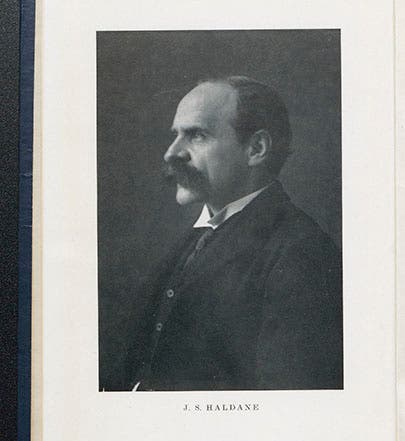Scientist of the Day - John Scott Haldane
John Scott Haldane, a Scottish physiologist, was born May 3, 1860. Haldane was the world's reigning expert on respiration in the early 20th century, and he was especially interested in substances that cause problems with breathing, such as noxious and poisonous gases. Miners had long been plagued with buildups of various gases in mines, which were called "damps". Thus we have black damp, white damp, choke damp, firedamp, and afterdamp. Haldane was the first to identify most of these; he discovered, for example, that afterdamp – named because it lingers after firedamp explodes – is a mixture of nitrogen, carbon dioxide, and carbon monoxide and is deadly because the carbon monoxide replaces oxygen in the blood and causes asphyxiation. It was Haldane who instituted the famous "miner's canary," a small bird or animal taken into the mines which will – quite unwillingly – warn of gas buildup by falling ill before the gas has yet affected humans. He also invented and built all sorts of apparatus to measure the presence of gases in mines and in the blood. One of the books by Haldane that we own, Methods of Air Analysis (1912) contains many diagrams and photos of such instruments; we show one of those here (second image).
In the summer of 1911, Haldane led an expedition to Pike's Peak, which rises to just over 14,000 feet, to do experiments on oxygen deprivation and acclimatization, the mechanism of which he became the first to understand. Then, with the outbreak of war in Europe, and the introduction of poison gas by the Germans in 1915, Haldane was sent over to the front lines to identify the gases, which turned out to be chlorine, and to come up with countermeasures. He designed the very first gas mask, called the Black Veil respirator, first used in May of 1915, which was simply a piece of black linen that held in place two gauze pads that were kept soaked in solution (third image). Since chlorine dissolves in water, this proved effective until deadlier gases, such as phosgene, were invented, and better masks were required.
Haldane also investigated deep-sea diving and the problem of the "bends" that had plagued people working in a high-pressure atmosphere ever since the first bridge caissons were sunk in the late 1860s. Haldane invented "stage decompression," the now-standard method of preventing the "bends" when deep-sea-diving, by pausing at various depths when ascending to allow the nitrogen in the blood to de-gas harmlessly, and he developed the crucial decompression timetables that are still used. In 1961, a distinguished group of respiration physiologists held a Centenary Symposium at Oxford (missing his centennial birthday by one year), where they honored the founder of their discipline with a plethora of papers. The portrait we reproduce was taken from the frontispiece of the printed volume of the proceedings (first image). In 2009, a blue plaque was unveiled at 11 Crick Road in Oxford, where Haldane once lived (fourth image).
Haldane was the father of John Burdon Sanderson Haldane, better known as J.B.S. Haldane, who not only coined the mesmerizing phrase, “an inordinate fondness for beetles”, but who investigated the origin-of-life problem in the 1920s, famously proposing that life might have arisen in some kind of "primordial soup" reacting with the earth's primitive atmosphere. How fitting, that the father investigated gases as a threat to life, and the son saw some of these same gases as the very source of life in the first place. Dr. William B. Ashworth, Jr., Consultant for the History of Science, Linda Hall Library and Associate Professor, Department of History, University of Missouri-Kansas City. Comments or corrections are welcome; please direct to ashworthw@umkc.edu.









